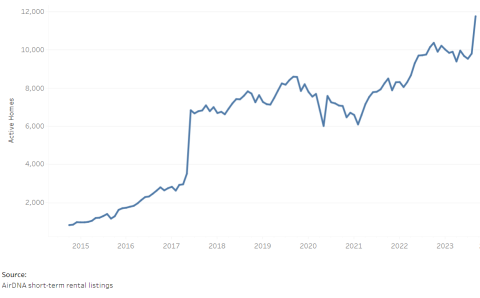New data on Vermont’s short-term rental (STR) market now available on HousingData.org shows a continued increase, up to 11,747 homes statewide in September 2023. Additionally, historic data has been added to the site, now displaying monthly figures, starting in October 2014.

The data shows continued growth in the number of homes used as STRs, with a 16% increase in the number of homes used as STRs statewide in September 2023 compared to the same month in the year earlier. September 2023 had the most active STRs (11,747 homes) and reservations (51,290 reservations) out of any month in Vermont on record. Average monthly revenue per rental slightly dipped from September 2022 to 2023, landing at $4,181 for the month. This leveling out comes after three years of significant revenue growth per STR since the beginning of the pandemic.
The hosts of Vermont’s growing ranks of homes used as STRs range from Vermont residents to individuals who live overseas. Fifty-five percent (55%) of the hosts of Vermont STRs were Vermont residents, based on preliminary analysis of March 2023 data. The remaining hosts were primarily from northeastern states, including New York (13%) Massachusetts (10%), Connecticut (6%) and New Jersey (5%). Data about host location was available for 51% of all Vermont STRs that month. Data on STR host characteristics is not yet available on HousingData.org.
What are Short-Term Rentals? (STRs)
Short-term rentals (STRs) are typically furnished apartments rented for short periods of time, instead of being annually leased or owner occupied. They are often used by travelers as an alternative to a hotel, as they may feature different amenities, prices, and locations than more traditional lodging. Vermonter’s opening their homes for short stays is not a new phenomenon. Today, traditional bed & breakfasts can still be found in many of the state’s historic downtowns, with some having first welcomed guests more than 100 years ago and others opening new to this day.
However, the practice has changed dramatically since the introduction of web-based listing sites such as AirBNB and Vrbo. Today, the ease of listing a home (or part of one) has led to the proliferation of homeowners doing so who may not otherwise have felt comfortable with this even ten years ago. In 2014, just over 1,000 homes statewide were listed on these sites as short-term rentals, according to AirDNA. More than 11,000 homes were actively used as short-term rentals for at least one night in Vermont in September 2023. That figure only includes full-unit rentals; partial homes, shared rooms, resorts, and traditional bed and breakfasts listed on these sites have been excluded.
Data about the short-term rental market in this data set includes listings collected by industry analyst AirDNA. AirDNA aggregates listings from several popular STR rental platforms, including AirBNB, HomeAway, and Vrbo. The VHFA (Vermont Housing Finance Agency) Research & Community Relations team uses a series of data processing techniques to update the public view on HousingData.org on a regular basis. Our team is working to refine the view with more useful data points to better display how changes in the STR market may be impacting the state’s larger housing market. In this process, we have re-spatialized the dataset to be more comparable to other housing metrics found on the site, with STR figures available for every Vermont town.
Vermont’s short-term rental conditions in September 2023
From the data, it is clear that the number of STRs in Vermont has significantly increased over time, with a marked increase in the number of units in the last three years. The larger trend was briefly halted by the impact of the COVID-19 pandemic and the associated travel restrictions, apparent in the stark decline in active homes in May 2020. From February 2021 onwards, the STR market made a swift recovery. There were about as many active STR homes in September 2019 (8,583 homes) as there were in September 2021 (8,237). The growth continued, with an additional ~1,700 units listed as STRs each year in September 2022 (10,131) and 2023 (11,747).
The data shows a seasonal cycle in the number of active STRs in the state. In this model, a unit is considered active if the home was listed and rented for at least one day in the noted month. Annually, September and October have the highest number of active STRs statewide. February, March, and November notably feature a lower active home total annually. This tracks with seasonal weather patterns and tourism trends.
The demand to stay in Vermont STRs has continuously increased over this period as well. In Sept. 2019, there were 33,892 full unit STR reservations in Vermont. Despite pandemic conditions that both hindered travel and limited the number of STRs available to rent, guests made 24,419 reservations at STRs in Vermont during Sept. 2020. Reservations made a full recovery to pre-pandemic levels in September 2021 and have continued to rise since. There were 51,290 STR reservations in Vermont in September 2023.
These changes are also reflected in the average monthly revenue per STR. Average revenue was below $2,000 in all months prior to June 2018, slowly rising to $2,460 by September 2019. That number jumped to $3,256 in 2020, then again to $3,948 in 2021. The rate of increase leveled out after that point, increasingly less drastically to $4,040 in Sept. 2022 and then $4,181 in 2023. However, it’s worth noting that average monthly revenue crossed $5,000 for the first time in February 2023. By contrast, the median gross rent in 2021 for a year-round rented Vermont home was $1,070 according to the Census Bureau.
Short-Term Rentals and Vacation Homes
It is likely that many homes listed consistently as short-term rentals are counted as seasonal homes by the Census. The Census Bureau categorizes any home not occupied by, or available to, a full-time renter or homeowner as “vacant.” Thus, “seasonal, vacation, or occasional use” homes are tracked by the Census as a type of vacant home.
Towns with the most short-term rental listings are consistently the ski resort towns of Stowe, Killington, Ludlow, Dover, and Warren. These towns are also the state’s top locations for the number of seasonal homes. Vermont’s seasonal homes account for about 16% of the state’s total housing stock, according to the Census Bureau. Short-Term Rentals account for about 3.6%, but from the data we cannot determine the overlap between these two figures.
Data shows that seventy-one percent (71%) of Vermont’s vacant homes are “seasonal, occasional use, or vacation homes” (44,057 homes). Vermont’s long-standing preponderance of seasonal homes offers a stark contrast to its extreme shortage of another type of vacant home—those for sale (4%). Only Maine had greater rates in both metrics than Vermont, at 72% and 4% respectively. While some of these seasonal homes could be used as year-round homes, many properties are unlikely to change status. At least some seasonal homes are unheated hunting cabins, lakeside camps with limited septic systems, or condominiums within ski resorts that are not suitable for year-round use.
For more information about the Short-Term Rentals conditions in specific towns, visit the view on HousingData.org. This view, and all others on the site, are available at the town and county level. STR figures, and all other data sources on HousingData.org, are updated regularly by the VHFA Research and Community Relations team.
Vermont Housing Finance Agency (VHFA) manages Housingdata.com to allow all Vermonters to access high-quality housing data and vetted policy practices. Housingdata.org was created as a direct extension of VHFA’s mission to promote affordable, safe housing opportunities for low- and moderate-income Vermonters. Check back on the site regularly to see data updates and new analysis about Vermont's housing conditions.

